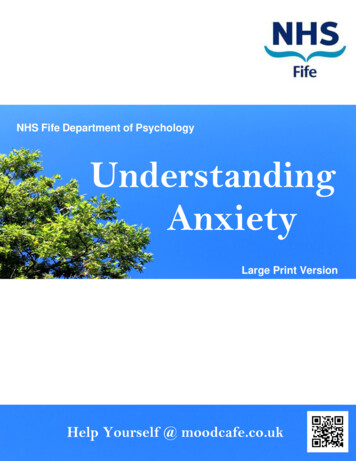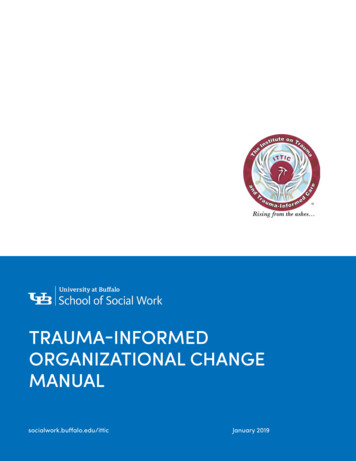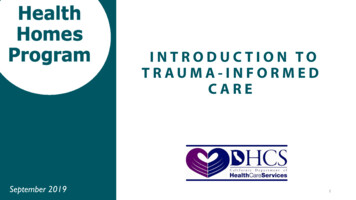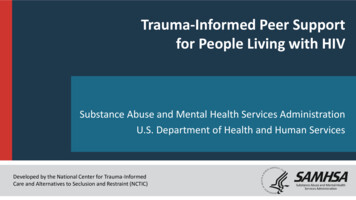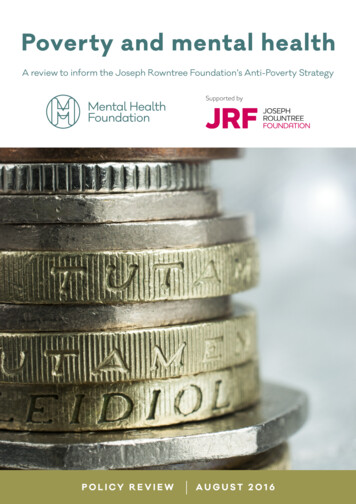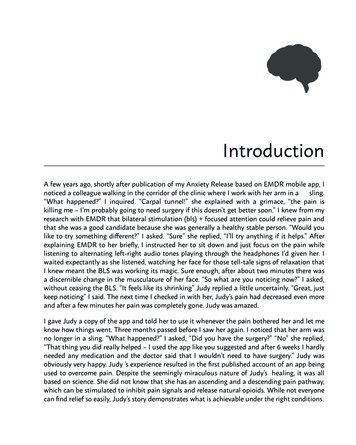
Transcription
IntroductionA few years ago, shortly after publication of my Anxiety Release based on EMDR mobile app, Inoticed a colleague walking in the corridor of the clinic where I work with her arm in asling.“What happened?” I inquired. “Carpal tunnel!” she explained with a grimace, “the pain iskilling me – I’m probably going to need surgery if this doesn’t get better soon.” I knew from myresearch with EMDR that bilateral stimulation (bls) focused attention could relieve pain andthat she was a good candidate because she was generally a healthy stable person. “Would youlike to try something different?” I asked. “Sure” she replied, “I’ll try anything if it helps.” Afterexplaining EMDR to her briefly, I instructed her to sit down and just focus on the pain whilelistening to alternating left-right audio tones playing through the headphones I’d given her. Iwaited expectantly as she listened, watching her face for those tell-tale signs of relaxation thatI knew meant the BLS was working its magic. Sure enough, after about two minutes there wasa discernible change in the musculature of her face. “So what are you noticing now?” I asked,without ceasing the BLS. “It feels like its shrinking” Judy replied a little uncertainly. “Great, justkeep noticing” I said. The next time I checked in with her, Judy’s pain had decreased even moreand after a few minutes her pain was completely gone. Judy was amazed.I gave Judy a copy of the app and told her to use it whenever the pain bothered her and let meknow how things went. Three months passed before I saw her again. I noticed that her arm wasno longer in a sling. “What happened?” I asked, “Did you have the surgery?” “No” she replied,“That thing you did really helped – I used the app like you suggested and after 6 weeks I hardlyneeded any medication and the doctor said that I wouldn’t need to have surgery.” Judy wasobviously very happy. Judy ’s experience resulted in the first published account of an app beingused to overcome pain. Despite the seemingly miraculous nature of Judy’s healing, it was allbased on science. She did not know that she has an ascending and a descending pain pathway,which can be stimulated to inhibit pain signals and release natural opioids. While not everyonecan find relief so easily, Judy’s story demonstrates what is achievable under the right conditions.
2 Change Your Brain, Change Your PainEven though you experience pain physically, chronic pain is a mind-body problem. In additionto physical discomfort chronic pain includes mental and emotional distress, changes in identity,altered immune functioning and neurological changes. Overcoming pain requires a holisticapproach which addresses all the elements that maintain it. While different approaches targetdifferent aspects of pain, your brain is where all these elements come together. All the physicalmental and emotional elements that maintain your pain are represented in your brain, as alteredpatterns of neural firing, biochemical reactions and even structural changes. This realizationhas paved the way for new strategies for overcoming pain. Its old news now that the brain isneuroplastic – capable of learning and changing throughout the life-span. Best-sellers such asNorman Doidge’s ‘The Brain That Changes Itself’ illustrate the power of neuroplasticity and thepopularity of this concept. Programs such as Lumosity use neuroplasticity to improve cognitiveperformance, health-related applications are aimed at delaying Alzheimer’s, stimulating immunefunction and even reducing physical inflammation.Applying neuroplasticity to pain is an exciting new possibility for a problem which is so resistantto other treatment modalities. Changing the brain activity that maintains pain is however alittle more challenging than say, learning to play the piano to improve cognitive performance.The neuroplastic processes that maintain pain involve substantial changes to many areas ofbrain functioning, structures and mental processing. These can come from chronic pain itself,or earlier life stress. For example, according to a recent review by US psychiatrist David AFishbain , 10 – 50% of chronic pain sufferers have PTSD compared with 10% of non-chronic painsufferers. My research suggests that, in non-veteran populations, at least as many again havelevels of anxiety that are consistent with PTSD. Other research indicates that 70% of chronicpain sufferers have attachment problems, compared with 50% of people without chronic pain.We know that childhood trauma or neglect cause neuroplastic changes, as well as disruption ofnormal sensory, mental and emotional integration, and that these changes increase vulnerabilityto pain. For example, adult survivors of childhood adversity are more likely to be injured, morelikely to develop chronic pain and less able to regulate negative affect adaptively. They are morereliant on unhealthy strategies such as workaholism or substance abuse, as opposed to socialsupport for self-soothing. They are also less able to experience positive affect, change maladaptivebehavioural responses, or learn new skills. Despite this many self-help texts treat chronic painas though it were no more than a form of aberrant acute pain, manageable through simplyadopting more adaptive patterns of thinking and behaving.A trauma-informed approachAlthough it may start with an injury, chronic often pain begins early in life as a result ofexperiencing adversity in the form of physical or emotional abuse and neglect. For example,upwards of 90% of women with fibromyalgia report having suffered trauma in their childhoodor adulthood. 76% of chronic low back pain sufferers report at least one trauma in their past.Chronic pain sufferers are more than twice as likely to suffer from PTSD (Posttraumatic Stress
Introduction 3Disorder) or PTSD like symptoms. Not surprisingly, the greater the adversity, the greater thelikelihood of developing pain. According to a recent review by the Institute for Chronic Pain,when compared to the general population, people with chronic pain tend to have at least doublethe rates of adversity.The connection between severe stress and pain is both well known and increasingly understood.In the short-term cortisol boosts your immune system to reduce inflammation, a key process inmany types of chronic pain. But prolonged stress results in fatigue, decreased cortisol levels andincreased susceptibility to pain-maintaining inflammation. Prolonged severe stress also causeschanges in brain structure and functioning such as increased excitability which makes the brainmore susceptible to pain-related activity. As pain expert Ronald Melzack wrote over 20 years ago,“Stressors have destructive effects on muscle, skeletal and hippocampal neural tissue, which maybecome the immediate basis of pain, or provide a basis for the devastating effects of later minorinjuries in which the severity of pain is disproportionately far greater than would be expectedfrom the injury.” Beyond its physical effects, severe stress also causes increased anxiety, tensionand altered sense of self. Chronic pain is thus best understood as a complex set of interactingphysical, neurological and psychological factors maintained by the effects of severe stress onmind and body.Change Your Brain, Change Your Pain addresses chronic pain from a trauma-informed perspective.We look at who you were before you developed pain and the role that unhealthy mental andemotional responses originating from earlier negative life experiences play in causing andmaintaining pain. In addition to learning pain control strategies and taking better care of yourself,this also requires making peace between your mental and emotional parts. There are manynames for the fragmentation that trauma causes; Child/adult, EP/ANP (Emotional personality/apparently normal personality) etc., but they all refer to the same thing, a split that occursbetween mental and emotional elements of experience when things get to be too much. Manysurvivors of childhood adversity have done such a great job of coping that they have forgotten ordissociated the reality of their childhoods. It just seems like they developed chronic pain insteadof healing normally after the injury or illness that precipitated it. But to the degree that your painis maintained by unresolved severe stress, trauma or neglect, you cannot overcome it withoutunderstanding what went before and how it has affected you.About this bookSo, this book begins by reviewing what we know about chronic pain at the most basic psychophysiological level. In chapters one and two we will review pain based on ‘first principles’, ascientific approach to problem-solving which begins by examining the very basic assumptionswe have regarding a problem, vs what we really know, and then building a new theory. You willdiscover the very basic processes which maintain pain in terms of the relationship between yourbody and your brain. You will learn how your brain works, how it is affected by severe stress,
4 Change Your Brain, Change Your Painand how those effects predispose you to chronic pain. You will learn how severe stress causes aseparation in the normal integration of physical, emotional and mental elements of experience,which most people are not aware of, which is one of the key causal factors of chronic pain.Chapter three introduces EMDR (Eye Movement Desensitization and Reprocessing) as atreatment for pain and describes a 7-step process for overcoming chronic pain which addressesthe various physical, mental and environmental challenges that chronic pain presents, namely;1. Tame the pain2. Emotional regulation3. Trauma processing4. Uncovering the meaning of your pain5. Dealing with other stressors6. Self-care7. ReintegrationThese steps are designed to help you learn to control your pain, resolve any pre-existing traumathat might be maintaining your pain and better manage the effects of pain on your mental andemotional functioning. You will be introduced to the fact that the ascending and descending painpathways are complimented by an ascending pain control system (Gate control) and a descendinganalgesic system. Each system represents an innate pain control mechanism complete with itsown pain-relieving neurotransmitters and/or endogenous (originating in the body) opioids.In chapters four and five you will learn how to tame your pain using ascending and descendingstrategies. Ascending strategies rely on sensory skin-based stimuli whereas descending strategiesrely on mental stimuli such as meditation and guided imagery. Bilateral stimulation focusedattention, a core treatment element of EMDR, harnesses both. You’ll be assisted in applyingthese strategies via the audio downloads that accompany this book, and/or the overcoming painapp (available via separate purchase).In chapters six and seven you will learn about the role of feelings in chronic pain and how toregulate them. You’ll find that feelings such as anxiety and depression are actually part ofan adaptive response to pain and that once understood and managed, can be helpful. Goodemotional regulation and connection with your feelings is also necessary for good self-care.Chapter eight demonstrates the role of trauma processing with EMDR as a path to resolvingchronic pain. With the help of a trained therapist, EMDR enables you to confront and movethrough any traumatic memories that might be maintaining your pain. Research suggests thatEMDR is most effective with pain that has a significant traumatic component (e.g.; phantomlimb pain), but as Judy’s story indicates, it can also help with other types of chronic pain.
Introduction 5In chapters nine and ten you will earn how to care for yourself, physically and emotionally. Goodself-care means living and interacting with the world with a moment to moment awareness andrespect for your physical and emotional needs. Exercise, diet, adequate rest, mental stimulation andemotional nourishment are the basic elements of self-care. They are also essential for neuroplasticityand physical and mental health. Good self-care reduces the negative emotional and behaviouralpatterns that are maintaining your pain and supports your mind-body system in combatting pain.Good self-care begins with developing a compassionate attitude toward yourself.In chapter eleven we will explore the meaning of your pain, from its obvious effects on physicalfunctioning to its deepest hidden psychological significance. What effect has pain had on howyou see yourself and how you have coped with past adversity? The more conscious you are aboutthe impact of your pain on your core self, the more you will be able to address it.Chapter twelve addresses the stressors that arise as a result of decreased functioning causedby chronic pain. Regardless of what you have may endured in the past, chronic pain brings itsown challenges. Decreased physical functioning, health uncertainty, medical treatment, changedrelationships and dealing with insurance companies are just some of the myriad added stressorsthat pain introduces into your life. You’ll learn how to change your mind-set and how to accessmental resources, such as problem-solving, to combat stress.Chapter thirteen describes what it feels like when you reach a point where you have regainedsome control, assimilated the losses, learned the lessons and grown a new post-pain self. Youcan enjoy life again, just not as the person you used to be. You may still have pain and decreasedfunctioning, but you are not defined by these things.How to get the most out of this bookYou can read this book from start to finish, or you can dive into different chapters according toyour needs. If you want to start by learning how to tame your pain, then you might begin withchapter four. If you’re not sure where to begin you might find the overview in chapter three helpfulfor assessing where you are at on your pain journey and where best to begin. Regardless of whatstage or task you are working on, you will find the accompanying audio a helpful addition to thesuggestions in the text. It’s recommended you listen with an open mind and find what works foryou.You will need to be patient – but by the time you complete the process outlined in this book, whichcould take anywhere from a month to a year or more, you should understand your pain more,have a greater sense of mastery over your pain, experience less suffering, and have developed anew sense of self that is able to incorporate the pain into your life in an adaptive way. This bookis not meant to be a substitute for professional help, but rather an adjunct to whatever medical,physical and psychological therapies you are already receiving.
The brain illustrations in this book are designed to be accessible to the non-professional, meaningthey contain just enough detail to help you understand the key brain structures and processesinvolved in your pain – they are not intended to be exact maps of brain structure or functioning.The approach in this book is based on EMDR, an integrative 8-phase approach which incorporatessensory stimulation, focused attention, free association and cognitive re-appraisal. Basically,noticing what new feelings are stimulated by bilateral stimulation and reviewing previousthought patterns in favour of more adaptive ones. The method is thought to harness an innateinformation processing capability which transforms painful experiences into new learnings andenables us to live in the present mentally, biologically and emotionally. Although it started out asa treatment for PTSD, research indicates EMDR can be efficacious in the treatment of emotionalproblems based on traumatic memories, including somatic manifestations of unresolvedemotional trauma.The ideas in this book are based on a combination of the results of my own published research,my reading of others’ research and brain science literature, and my own clinical experience. Thescientific references for each chapter can be found at the end of the book.Wishing you peace, comfort and healing,Mark Grant MAMelbourne, AustraliaJanuary, 2020
experiencing adversity in the form of physical or emotional abuse and neglect. For example, upwards of 90% of women with fibromyalgia report having suffered trauma in their childhood or adulthood. 76% of chronic low back pain sufferers report at least one trauma in their past.



